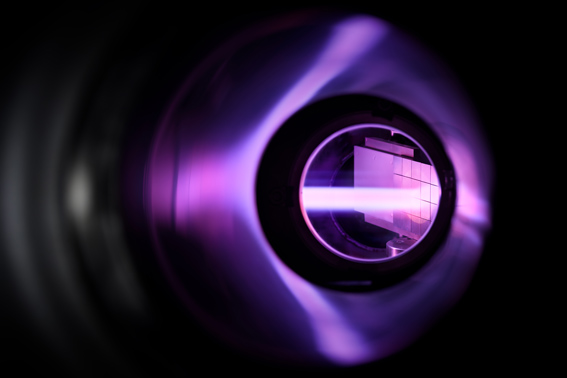“Magnum-PSI can create very high density plasmas and we are interested in the impact of the plasmas on the wall and the plasma-facing components,” says Jonathan van den Berg-Stolp. He is the first author of a publication which was recently accepted by Nuclear Fusion. Jonathan van den Berg is a PhD student in the Plasma Edge Physics and Diagnostics group at DIFFER. Recent experiments have shown that the velocity of the plasma flux near the wall in Magnum-PSI is going down with increasing plasma density.

Photo: Bart van Overbeeke
When a plasma touches the wall, the electrically charged particles (ions) in the plasma are neutralized. This neutralized gas interacts with the ions. Especially in the dense conditions of Magnum-PSI, this interaction reduces the speed and energy of the #plasma near the wall. In this way, the plasma load on the wall is reduced. This happens in a region only a few millimeters away from the wall.
These results are relevant to fusion reactors like ITER, which is being built in southern France. At the bottom of the ITER vacuum vessel, which will contain the plasma of the reactor, a divertor will extract heat and ash produced by the fusion reaction. The divertor is made of tungsten, the metal with the highest melting point, and it protects the surrounding walls from high temperatures and high-speed neutrons.
“There is an overlap between Magnum-PSI and ITER divertor conditions,” says Van den Berg , “and the near-surface interaction region in ITER is expected to be even smaller than in Magnum-PSI. But it is also good to keep in mind that Magnum-PSI and ITER do not have the same geometry and angle of plasma incidence, which will affect the interaction with the neutral gas.” Therefore it is important to include these effects in the modeling of plasma-wall interaction in future fusion machines.”
Publication
Jonathan van den Berg-Stolp, Hennie Johannes van der Meiden, Ivo G J Classen, Jordy Vernimmen, Yu Li, John Scholten, Serge Brons and Gerard J Van Rooij
Thermalized collisional pre-sheath detected in dense plasma with coherent and incoherent Thomson scattering
Nuclear Fusion, Accepted Manuscript online 2 July 2021
Go to the News page.